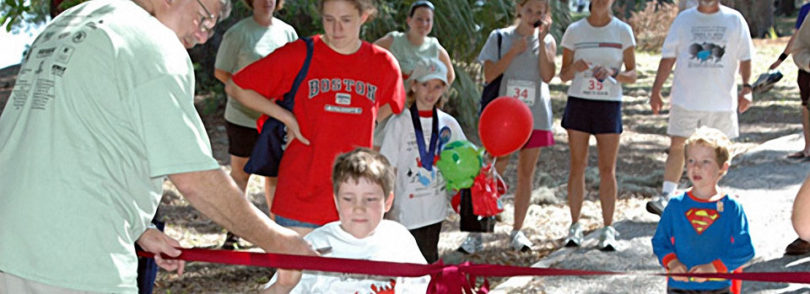For the first time in his life, 9-year-old Savannah-native Jay Norris led the way to the water, racing through maritime forest and salt marsh toward the Skidaway River, his wheelchair rolling smoothly over the surface of the trail.
“It’s the first time he’s been on an off-road path and not attached to my back,” said his mother, Dawn Norris. “He was out ahead of me, as independent and carefree as you can expect a 9-year-old to be.”
Jay Norris can now learn first-hand about salt marsh ecology and the Georgia coast thanks to the new Americans with Disabilities Act (ADA)-funded boardwalk and nature trail on Skidaway Island, Ga.
“I saw fiddler crabs, little snails and marsh,” said Jay Norris, who cut the ribbon for the trail’s grand opening on May 20, 2006. “It was great and awesome. I liked it a bunch.”
The University of Georgia’s Marine Education Center and Aquarium on Skidaway Island supports year-round educational programs for both youth and adults, and provides an overview of the physical and biological processes that shape the Georgia coast.
“We continually try to expand our offerings to the general public, both locally and regionally,” said Bob Williams, interim associate director for marine education. “With the boardwalk and nature trail, we had an opportunity to expand what we have to offer outside the building.”
Marine educators imagined building a universally accessible boardwalk that would not only extend over the marsh but also serve as an alternative teaching space to the laboratories, classrooms and original dirt and gravel pathways already in use.
“Our classes were having some impact on the salt marsh,” said marine education specialist John Crawford. “They can’t help but trample on the mud. The marsh recovers, but it takes a little while. We were looking for an alternative and thought maybe a boardwalk would be a way to go.”
The new Jay Wolf Nature Trail begins at the aquarium and winds through a canopy of live oak and laurel trees dripping with Spanish moss before entering the dense woods of maritime forest. Interpretive signs along the way identify trees, plants, and shrubs and provide information on Georgia’s coastal ecology. A few hundred yards into the forest, the trail connects to a new wooden boardwalk that extends over the marsh to the Skidaway River.
A platform at the end of the boardwalk allows marine educators to give presentations to groups overlooking the marsh and the river. Every 100 feet or so, gates in the four-feet-high railing open to allow interactive teaching and interpretive education and better views for children and people with disabilities.
“Now with the gates students using a wheelchair can raise and lower anything from a hula hoop to a meter-square sampling device down to the marsh,” Crawford said. That means more interaction with Georgia’s coastal environment, especially for people like Jay Norris who live near the water but have been unable to explore their surroundings on their own.







